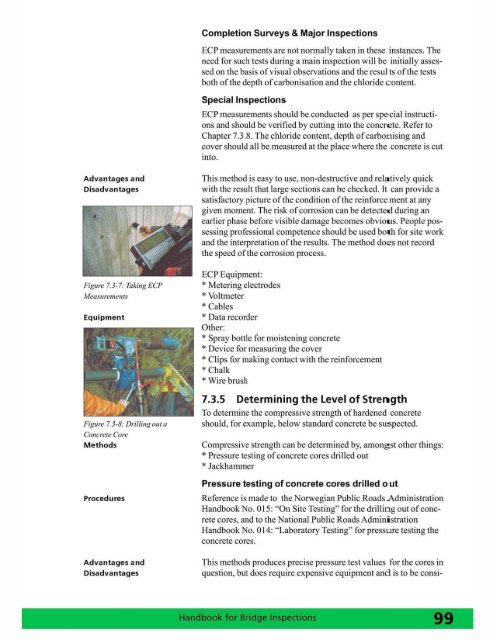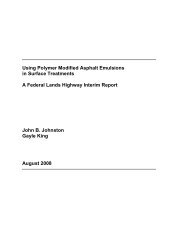Handbook for Bridge Inspections - TSP2
Handbook for Bridge Inspections - TSP2
Handbook for Bridge Inspections - TSP2
You also want an ePaper? Increase the reach of your titles
YUMPU automatically turns print PDFs into web optimized ePapers that Google loves.
Completion Surveys & Major <strong>Inspections</strong><br />
ECP measurements are not normally taken in these instances. The<br />
need <strong>for</strong> such tests during a main inspection will be init iallyassessed<br />
on the basis of visual observati ons and the resul ts of the tests<br />
both of the depth of carbonisation and the chloride c ontent.<br />
Special <strong>Inspections</strong><br />
EC P measurements should be conducted as per special instructions<br />
and should be verified by cutti ng into the concrete. Refer to<br />
Chapter 7.3.8. The chloride content, depth of carbonising and<br />
cover should all be measured at the place where the concrete is cut<br />
inlo.<br />
Advantages and<br />
Disadvantages<br />
•<br />
FigWl? 7.3-7: Takil/g ECP<br />
AI eusu rem e illS<br />
Equipment<br />
Figure 7.3-8: Drillil/g Ollt (I<br />
Concrete Core<br />
Methods<br />
This method is easy to use, non-destructive and rel"tively quick<br />
with the resu lt that large secti ons can be checked. It can provide a<br />
satisfactory picture of the cond ition of the rein<strong>for</strong>ce ment at any<br />
given moment. The risk of corrosion can be detectetd during an<br />
earl ier phase be<strong>for</strong>e visible damage becomes obvious. People possessing<br />
professional competence should be used both <strong>for</strong> site work<br />
and the interpretation of the results. The method does not record<br />
the speed of the corrosion process.<br />
ECP Equipment:<br />
• Metering electrodes<br />
• Voltmeter<br />
• Cables<br />
• Data recorder<br />
Other:<br />
• Spray bottle <strong>for</strong> moistening concrete<br />
• Device <strong>for</strong> measuring the cover<br />
• Clips <strong>for</strong> mak ing contact wilh the rein<strong>for</strong>cement<br />
• Chalk<br />
• Wire brush<br />
7.3.5 Determining the level of Strength<br />
To detennine the compressive strength of hardened concrete<br />
should, <strong>for</strong> example, below standard concrete be suspected.<br />
Compressive strength can be determined by, amongst other things:<br />
• Pressure testing of concrete cores dri lled out<br />
• Jackhammer<br />
Pressure testing of concrete cores drilled 0 ut<br />
Procedures<br />
Advantages and<br />
Di sadvantages<br />
Reference is made to the Norwegian Public Roads Admini stration<br />
<strong>Handbook</strong> No. 015: "On Site Testing" <strong>for</strong> the drilliog Oul of concrete<br />
cores, and to the Nat ional Public Roads Administration<br />
<strong>Handbook</strong> No. 014: " Laboratory Test ing" fo r pressure testing the<br />
concrete cores.<br />
This methods produces precise pressure test val ues <strong>for</strong> the cores in<br />
question, but does req uire expensive equipment and is to be consi-
















